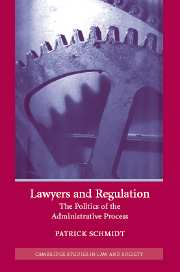Book contents
- Frontmatter
- Contents
- List of figures and tables
- Table of cases
- Acknowledgments
- List of abbreviations
- 1 Introduction
- 2 The contours of a regulatory bar
- 3 Administrative rulemaking
- 4 Rulemaking litigation
- 5 Enforcement
- 6 Regulatory counseling
- 7 Conclusion
- Appendix 1 Research methods
- Appendix 2 Survey instrument
- Notes
- Bibliography
- Index
2 - The contours of a regulatory bar
Published online by Cambridge University Press: 11 July 2009
- Frontmatter
- Contents
- List of figures and tables
- Table of cases
- Acknowledgments
- List of abbreviations
- 1 Introduction
- 2 The contours of a regulatory bar
- 3 Administrative rulemaking
- 4 Rulemaking litigation
- 5 Enforcement
- 6 Regulatory counseling
- 7 Conclusion
- Appendix 1 Research methods
- Appendix 2 Survey instrument
- Notes
- Bibliography
- Index
Summary
Communities of lawyers rarely are homogeneous populations, especially when they stretch across entire nations. Complimentary popular myths about the solo practitioner and the elite, large-firm attorney only hint at the multifaceted nature of the legal profession. For legal scholars and sociologists, cleavages within the bar have provided gateways to understanding the relationship of lawyers to the legal system, mainstream politics, and society. The most common strategy of commentators has been to identify a set of legal “elites” within the bar or society in order to explore diverse issues, including the collective inaction of lawyers, collective impact, intra-bar disputes, the homogenization of legal concepts, and lawyers' relationship to political legitimacy. However defined, descriptions of legal elites generally emphasize the importance of social background in elevating a subset of the bar to positions of leadership and control over the profession's collective voice. The success of this approach in empirical research calls for recognition of the social status of lawyers whenever attempting to assess their role in wider political and legal systems.
This chapter provides an overview of the OSHA bar, both the divisions within the bar and those that distinguish this regulatory practice from other segments of the legal profession. Most attempts to understand lawyers have focused on geography; an account of a “regulatory bar” has few precedents to suggest the perspective of attorneys in this field.
- Type
- Chapter
- Information
- Lawyers and RegulationThe Politics of the Administrative Process, pp. 29 - 53Publisher: Cambridge University PressPrint publication year: 2005



